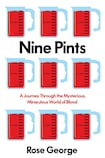
Do you know your blood type? As a person who has had a sizeable amount of transfusions (150) and an aggressive blood cancer (acute leukaemia), this is a question I nosily ask with alarming regularity of others.
To me, it’s an endlessly intriguing substance, but most people will think of their blood only on receipt of a paper cut, an injury or undergoing a transfusion. Blood has connections not just to medicine, but to art, etymology, religion and philosophy, and I’m grateful not only that Rose George is as fascinated as I am, but because she’s one of the most qualified authors to write on the subject.
George is an acclaimed journalist and writer, rigorous to a fault and one who can take a single subject and refract it into a many-splintered thing. Deep Sea and Foreign, her in-depth account of the shipping industry, explored marine law, economics and the environment. A previous book, The Big Necessity, focused on another bodily fluid (human waste) and is closer, subject-wise, to this one.
There is an eloquent account of the stigma surrounding Aids in the 1980s and the ongoing worldwide battle to eradicate HIV, Zika and Ebola
Here George promises a deep dive on blood as “a medicine, a lifesaver and a commodity that is dearer than oil”. There are artificial joints and hearts, but still nothing that mimics the complexity of blood, and science has failed to find a lab-made substitute for it.
Transfusions
The starting point is the subject of transfusion and the statistic that every three seconds, someone in the world receives one. In the West, we take for granted the availability of safe, accessible donations, but it’s a complicated industry, which varies from country to country, and not just around safety protocols. The UK and Ireland rely on the altruism of others with voluntary donation, while in India, family members must sign up to donate for relatives. Demand outstrips supply. Of the 176 countries surveyed by the World Health Organisation, 80 nations said that only 1 per cent of its population actually gives blood, when a nation requires 1-3 per cent of donations to keep supplies up.
From transfusion to leeching, Rose informs us that there are only half a dozen suppliers of medical leeches in the world. She visits one business in Wales and discovers that the creatures can inject their own anaesthetic and emit “the best anti-coagulant known to man”. They can, terrifyingly, also escape from the tanks they’re kept in.
In the Blood Borne chapter, there is an eloquent account of the stigma surrounding Aids in the 1980s and the ongoing worldwide battle to eradicate diseases like HIV, Zika and the Ebola virus. In 2017, she points out that the US government changed its website from Aids.gov to HIV.gov, because due to advancement in treatment “now hardly any Americans die of AIDS”. It contrasts hugely with the situation in South Africa, where “blessers” – young girls who have transactional sex with older men for money or gifts – often end up with HIV.
Shame
Another kind of stigmatised shame is dealt with in chapters on attitudes to menstruation and feminine hygiene. In parts of rural India, the practice of chaupadi still exists, where menstruating girls are banished to small huts, have no contact with their family and permitted to eat only rice. Some have died of exposure or snakebites; others have been raped.
Elsewhere in the country, girls have benefitted from cheap sanitary products created by Muraga, an Indian social entrepreneur dubbed the “Menstrual Man”. For research, he wore a fake uterus made from a football filled with goat blood. George meets him, and many others, interviewing and managing to be both empathetic and no nonsense, inquiring but not intrusive.
George has clearly undertaken a huge volume of research, but it's presented engagingly, often sardonically
Part of this empathy relates to George herself: she is a frequent blood donor, an endometriosis sufferer with difficult periods, and is going through menopause.
The book is full of striking facts and disturbing stories: leeches need to be exercised twice a day; clinical vampirism, studies into whether animals are attracted to menstrual blood, “blood bikers” who voluntarily deliver blood to UK hospitals; the 2008 case in Gorakhpur in India, where poor migrant men were being bled to death as blood slaves.
What’s notable about George’s work – and, in particular, this book – is her approach to the subject and how deftly she communicates vast tracts of information. George has clearly undertaken a huge volume of research and travel, but it’s presented engagingly, often sardonically. The reader rarely feels bombarded with academic science or medicalese, unlike many books in this area which scare off readers.
Nine Pints is a hugely intelligent, humane and riveting work, and from illness to industry, George is an engaging guide through the bloodstream.











